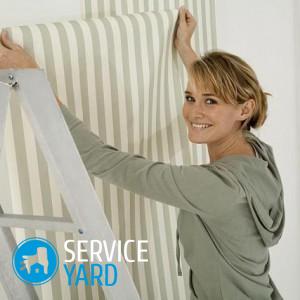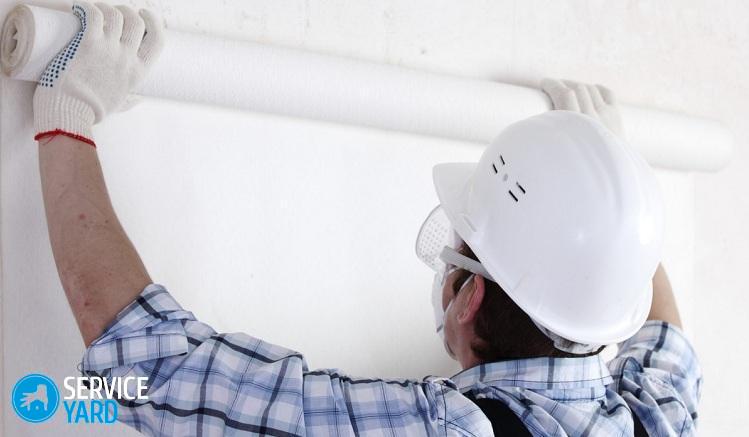Bubbles on the wallpaper after sticking - what to do?

Wallpaper is a beautiful and practical type of wall covering. Vinyl, non-woven, acrylic, bamboo or ordinary paper - they involve gluing walls, but the methods of operation are significantly different. The appearance of wall surfaces depends not only on what type of coating is glued to them, but also on the quality of the work performed. The formation of characteristic bubbles on the wallpaper is one of the problems with gluing walls. This is not just ugly. The canvas exfoliates at the joints, and may even fall off the surface. If there are bubbles on the wallpaper after sticking - what to do? Before taking any measures, it is necessary to find out the cause of the appearance of swelling. It is possible that no intervention will be needed.
to contents ↑The reasons for the appearance of bubbles on the wallpaper
Wallpaper is quite thin material. Even solid vinyl and non-woven fabrics can not fully hide all the defects of the walls. And if you manage to hide a minor defect, then one way or another he will declare himself when gluing. For this reason, you need to pay attention to the preliminary preparation of the walls no less than the finish.
Cracks, bumps, old plaster, chips can provoke the appearance of blisters. Before mounting wallpaper on the walls, it is necessary to minimize all defects.
Important! Sometimes you can’t get off with the usual leveling of surfaces. If, for example, the plaster has worn out significantly and it is clear that it will not hold anyway, care must be taken to remove it. Putting on top of weak plaster wallpaper is useless. Wallpaper will go cracks and bubbles. As you can see, if you do not take measures, you will have to redo everything all over again.
The appearance of blisters can contribute to such reasons.
Ground preparation not done
Unfortunately, jobs like primer and putty are often neglected. Avoid these operations, even if the walls are perfectly smooth. Putty promotes perfect alignment of the walls, and the primer improves adhesion (adhesion of glue to the wall surface). If you neglect this, then even the highest quality glue, applied with a thick layer on the walls, does not save. Due to poor adhesion, the fabric sticks poorly and is taken in bubbles.
Dry time not observed
An attempt to stick a wallpaper onto a damp wall surface is unsuccessful. It is important that the plaster, putty and primer dry properly. Otherwise, the trellises will begin to exfoliate from the walls, and all the work will have to be redone again.
Application of glue in an uneven layer
This is the most common reason why bubbles appear on the wallpaper after pasting. In particular, this applies to those types of wallpaper when you need to apply glue to the material itself and to the walls. If the glue is not absorbed, the wallpaper partially moves away from the wall. Hence the air cavity.
Non-compliance with glue drying
Any wallpaper glue is a water-soluble composition. To dry completely, moisture must evaporate. As a rule, this takes about two days. At this time, the room must be kept closed, avoiding drafts and temperature extremes.
to contents ↑Important! It is undesirable for sun rays to fall onto freshly glued canvases.
How to eliminate bubbles?
So what to do if the wallpaper is bubbling after sticking? Large swellings are immediately noticeable. As a rule, the easiest way to deal with them. It is enough to smooth the canvas thoroughly with a spatula or rubber roller.Often this phenomenon occurs when sticking heavy panels on a non-woven basis due to the fact that the glue did not have time to absorb.
You can act in two ways:
- Peel off the canvas from the wall, re-apply glue and mount the wallpaper.
- Drive the air out from under the wallpaper with a spatula, and carefully collect the remaining glue.
Important! With partial absorption of glue, the material becomes more plastic. When the adhesive composition dries, the wallpaper is stretched, and the wall looks completely smooth. Therefore, experts advise not to rush, but to wait for the glue to dry.
If the defects are still noticeable, then other methods will have to be applied.
Bubbles left after drying
What to do if the wallpaper is swollen after gluing? On the Internet, you can sometimes meet the advice “gently cut the bubble”. You can do this, but in most cases the trace from the cut will still be noticeable.
To remove ugly bloats on wallpaper, you need a special glue and a syringe:
- Puncture the bubble with a needle or sharp blade.
- Put wallpaper glue into the syringe and fill the cavity.
- Now carefully smooth out what remains of the bubble, in the direction from the center to the edges, and remove the excess wallpaper glue.
- Wipe the wall in the area of sticking with a clean cloth.
- It is advisable not to ventilate the room for at least a day, but to wait for the composition to completely dry.
to contents ↑Important! PVA glue cannot be used for wall pasting, since it does not dissolve in water. With subsequent repairs, dismantling the old coating will turn into a problem with many unknown problems. In addition, after the composition has dried, yellow spots remain.
Stock footage
Removing blisters from the trellis is not a particularly difficult process, but one cannot expect absolute success. For example, inexpensive paper webs may warp or change color. This is precisely the case when “it is easier to prevent a disease than to treat it.” The best option is to prevent the appearance of bubbles on surfaces, strictly follow the instructions for using glue, and not be too lazy to prime the surface. Then the question will not arise what to do if bubbles appeared after wallpapering.
- How to choose a vacuum cleaner taking into account the characteristics of the house and coatings?
- What to look for when choosing a water delivery
- How to quickly create comfort at home - tips for housewives
- How to choose the perfect TV - useful tips
- What to look for when choosing blinds
- What should be running shoes?
- What useful things can you buy in a hardware store
- Iphone 11 pro max review
- Than iPhone is better than Android smartphones




